Medial Collateral Knee Ligament Sprain
■ ■ ■ Description
Medial collateral knee ligament sprain is a sprain (tear) of one of the four major ligaments of the knee. The medial collateral ligament (MCL) is a structure that helps keep the normal relationship of the femur (thigh bone) and the tibia (leg bone) along the inner side of the knee. The MCL prevents the knee from buckling inward and is the ligament most commonly injured in sports. When torn, this ligament usually heals, although it may heal in a lengthened position (slightly loose). Sprains are classified into three grades. In a first-degree sprain the ligament is not lengthened but is painful. With a second- degree sprain, the ligament is stretched but still functions. With a third-degree sprain, the ligament is torn and does not function.
■ ■ ■ Common Signs and Symptoms
-
Pain and tenderness on the inner side of the knee
-
A popping, tearing, or pulling sensation noted at the time of injury
-
Swelling and bruising (after 24 hours) at the site of injury
-
With lesser degrees of injury, may continue to play
-
Knee stiffness
-
Limping, often walking with bent knee
■ ■ ■ Causes
MCL sprains are caused by force that exceeds the strength of the ligament. Most commonly this injury is the result of a direct blow to the outer side of the knee, usually while the foot is on the ground, although it may also be a result of a noncontact injury.
■ ■ ■ Risk Increases With
-
Contact sports (football, rugby) and sports that require pivoting and cutting (sudden change of direction), such as soccer and baseball
-
Poor physical conditioning (strength and flexibility)
-
Improper equipment
■ ■ ■ Preventive Measures
-
Appropriately warm up and stretch before practice
and competition.
-
Maintain appropriate conditioning:
-
Thigh, leg, and knee flexibility
-
Muscle strength and endurance
-
Cardiovascular fitness
-
-
Wear proper protective equipment (such as the correct
length of cleats for surface).
-
Functional braces may be effective in preventing injury,
especially re-injury.
■ ■ ■ Expected Outcome
The MCL usually heals on its own with appropriate treatment.
Rarely, isolated severe MCL injuries require surgery.
■ ■ ■ Possible Complications
-
Frequent recurrence of symptoms, such as knee giving way, instability, and swelling
-
Injury to meniscal cartilage, resulting in locking and swelling of the knee
-
Injury to articular cartilage, possibly resulting in knee arthritis
-
Injury to other ligaments of the knee
-
Knee stiffness (loss of knee motion)
■ ■ ■ General Treatment Considerations
Initial treatment consists of medications and ice to relieve pain and reduce the swelling of the knee. Walking with crutches until you walk without a limp is often recommended (you may put full weight on the injured leg). Your physician may recommend a knee brace with a hinge to help regain knee motion while protecting the MCL. Range-of-motion, stretching, and strengthening exercises may be carried out at home, although referral to a physical therapist or athletic trainer is usually recommended. Rehabilitation of MCL sprains generally concentrates on reducing knee swelling, regaining knee range of motion, regaining muscle control and strength, and a short period of bracing. For severe MCL sprains or those associated with other knee ligament injuries, surgery may be recommended.
■ ■ ■ Medication
-
Nonsteroidal anti-inflammatory medications, such as aspirin and ibuprofen (do not take within 7 days before surgery), or other minor pain relievers, such as acetaminophen, are often recommended. Take these as directed by your physician. Contact your physician immediately if any bleeding, stomach upset, or signs of an allergic reaction occur.
-
Stronger pain relievers may be prescribed as necessary by your physician. Use only as directed and only as much as you need.
■ ■ ■ Heat and Cold
-
Cold is used to relieve pain and reduce inflammation. Cold should be applied for 10 to 15 minutes every 2 to 3 hours for inflammation and pain and immediately after any activity that aggravates your symptoms. Use ice packs or an ice massage.
-
Heat may be used before performing stretching and strengthening activities prescribed by your physician, physical therapist, or athletic trainer. Use a heat pack or a warm soak.
■ ■ ■ Notify Our Office If
-
Symptoms get worse or do not improve in 4 to 6 weeks despite treatment
-
New, unexplained symptoms develop (drugs used in treatment may produce side effects)
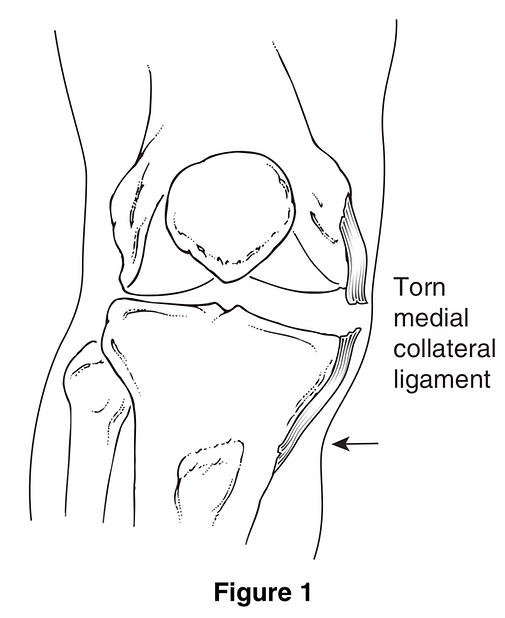
➢RANGE OF MOTION AND STRETCHING EXERCISES • Medial Collateral Knee Ligament Sprain—Phase I
These are some of the initial exercises you may start your rehabilitation program with until you see your physician, physical therapist, or athletic trainer again or until your symptoms are resolved. If any of these exercises causes pain or discomfort, consult your physician, physical therapist, or athletic trainer. Please remember:
-
Flexible tissue is more tolerant of the stresses placed on it during activities.
-
Each stretch should be held for 20 to 30 seconds.
-
A gentle stretching sensation should be felt.
RANGE OF MOTION • Knee Flexion
-
Lie on your back with your legs out straight.
-
Slowly slide your heel toward your buttocks. Bend your knee as far as is comfortable to get a stretching sensation.
-
Hold for seconds.
-
Return your leg to the starting position.
-
Repeat exercise times, times per day.

RANGE OF MOTION • Knee Flexion and Extension
-
Sit on the edge of a table or chair.
-
Use the uninjured/unaffected leg to straighten (extend) and bend (flex) the injured/affected leg.
-
Flexion—Cross your ankles, placing the uninjured or unaffected leg on top of the injured/affected leg. Pull your heel(s) backward under the surface you are sitting on to increase the amount you can bend your knee.
-
Extension—Cross your ankles, placing the uninjured or unaffected leg under the injured/affected leg. Pull your heel(s) backward under the surface you are sitting on to increase the how much you can straighten your knee.
-
Repeat exercise times, times per day.

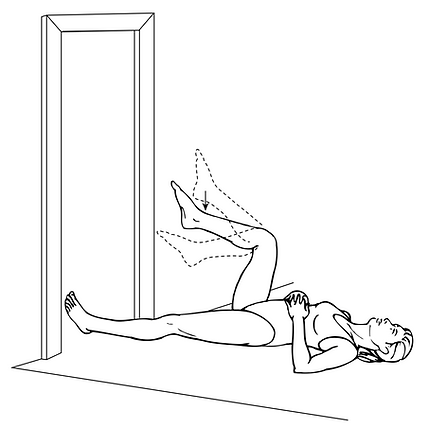
RANGE OF MOTION • Gravity Knee Flexion
-
Lie on the floor as shown with your toes/foot lightly touching the wall.
-
Allow your toes/foot to slide down the wall, allowing gravity to bend your knee for you.
-
Obtain a “comfortable” stretching sensation.
-
Hold this position for seconds. Then return the leg to the starting position.
-
Repeat exercise times, times per day.
RANGE OF MOTION • Knee Extension Sitting
-
Sit with your leg/heel propped on another chair as shown. You may also prop your foot up on a rolled-up towel, a table, or a foot stool.
-
Relax, letting gravity straighten out your knee.
-
Hold this position for seconds.
-
Repeat exercise times, times per day.
Note: If authorized by your physician, physical therapist, or athletic trainer, you may place a _____ pound weight on your thigh just above your kneecap to obtain a more effective stretch.

➢ STRENGTHENING EXERCISES • Medial Collateral Knee Ligament Sprain—Phase I
These are some of the initial exercises you may start your rehabilitation program with until you see your physician, physical therapist, or athletic trainer again or until your symptoms are resolved. Please remember:
-
Strong muscles with good endurance tolerate stress better.
-
Do the exercises as initially prescribed by your physi- cian, physical therapist, or athletic trainer. Progress slowly with each exercise, gradually increasing the number of repetitions and weight used under their guidance.
STRENGTH • Quadriceps, Isometrics
-
Lie flat or sit with your leg straight.
-
Tighten the muscle in the front of your thigh as much as
-
you can, pushing the back of your knee flat against the floor.
This will pull your kneecap up your thigh, toward your hip.
4. Hold the muscle tight for seconds.
5. Repeat this exercise times, times per day.
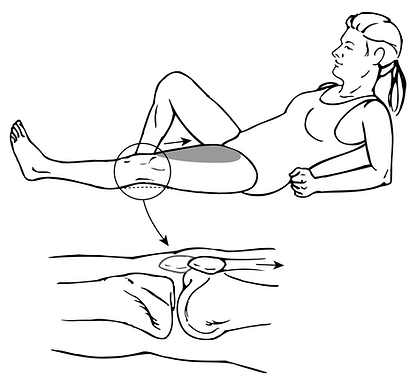

STRENGTH • Quadriceps, 7 Count
The quality of the muscle contraction in this exercise is what counts the most, not just the ability to lift your leg!
-
Tighten the muscle in front of your thigh as much as you can, pushing the back of your knee flat against the floor.
-
Tighten this muscle harder.
-
Lift your leg/heel 4 to 6 inches off the floor.
-
Tighten this muscle harder again.
-
Lower your leg/heel back to the floor. Keep the muscle in front of your thigh as tight as possible.
-
Tighten this muscle harder again.
-
Relax.
-
Repeat exercise times, times per day.

STRENGTH • Hamstring, Isometrics
-
Lie on your back on the floor or a bed.
-
Bend your knee approximately degrees.
-
Pull your heel into the floor or bed as much as you can.
-
Hold this position for seconds. Rest for seconds.
-
5. Repeat exercise times, times per day.
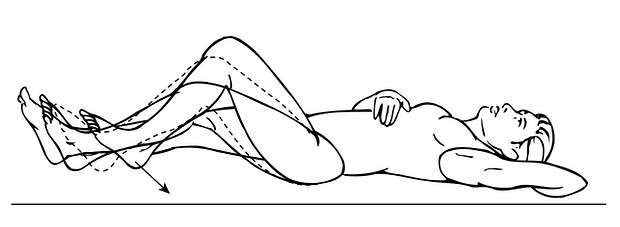
STRENGTH • Hamstring, Curls
-
Lie or your stomach with your legs out straight.
-
Bend knee to 90 degrees. Hold this position for seconds.
-
Slowly lower your leg back to the starting position.
-
Repeat exercise times, times per day.
Additional Weights: OK TO USE DO NOT USE!!!
If okay’d by your physician, physical therapist, or athletic trainer, a pound weight may be placed around your ankle for additional weight.

➢RANGE OF MOTION AND STRETCHING EXERCISES • Medial Collateral Knee Ligament Sprain—Phase II
These are some of the exercises you may progress toin your rehabilitation program. Do not progress to these until you have been authorized to do so by your physician, physical therapist, or athletic trainer. You may also continue to use all Phase I exercises. Please remember:
-
These exercises are meant to gradually allow you to regain motion without increasing any swelling.
-
Each stretch should be held for 20 to 30 seconds.
-
A gentle stretching sensation should be felt.
STRETCH • Quadriceps, Prone
-
Lie on your stomach as shown.
-
Bend your knee, grasping your toes, foot, or ankle. If you are too “tight” to do this, loop a belt or towel around your ankle and grasp that.
-
Pull your heel toward your buttock until you feel a stretching sensation in the front of your thigh.
-
Keep your knees together.
-
Hold this position for seconds.
-
Repeat exercise times, times per day.

RANGE OF MOTION • Knee Extension, Prone
-
Lie on your stomach on a bed or sturdy table with your knee and leg off the table. The kneecap should be off the edge of the bed or table.
-
Allow gravity to straighten your knee for you.
-
Hold this position for seconds.
-
Repeat exercise times, times per day.
Note: If authorized by your physician, physical therapist, or athletic trainer, you may place a _____ pound weight on your ankle to obtain a more effective stretch.

➢ STRENGTHENING EXERCISES • Medial Collateral Knee Ligament Sprain—Phase II
These are some of the exercises you may progress toin your rehabilitation program. Do not progress to these until you have been authorized to do so by your physician, physical therapist, or athletic trainer. You may also continue to use all Phase I exercises. Please remember:
-
Strong muscles with good endurance tolerate stress better.
-
Do the exercises as initially prescribed by your physician, physical therapist, or athletic trainer. Progress slowly with each exercise, gradually increasing the number of repetitions and weight used under their guidance.
STRENGTH • Quadriceps, Short Arcs
-
Lie flat or sit with your leg straight.
-
Place a inch roll under your knee, allowing it to
bend.
-
Tighten the muscle in the front of your knee as much as
you can, and lift your heel off the floor.
-
Hold this position for seconds.
-
Repeat exercise times, times per day.
Additional Weights: OK TO USE DO NOT USE!!!
If okay’d by your physician, physical therapist, or athletic trainer, a pound weight may be placed around your ankle for additional weight.


STRENGTH • Quadriceps, Step-Ups
-
Use a step or books.
-
Place your foot on the step or books approximately inches in height. Make sure that your kneecap is in line with the tip of your shoe or your second toe.
-
Hold on to a hand rail, chair, wall, or another object for balance if needed.
-
Slowly step up and down. Make sure that the kneecap is always in line with the tip of your shoe or your second toe. Lightly touch the heel of the opposite leg to the floor and return to the starting position.
-
Repeat exercise times, times per day.
STRENGTH • Quadriceps, Wall Slide
-
Stand with your back against the wall. Your feet should be shoulder-width apart and approximately 18 to 24 inches away from the wall. Your kneecaps should be in line with the tip of your shoes or your second toe.
-
Slowly slide down the wall so that there is a degree bend in your knees. (Your physician, physical therapist, or athletic trainer will instruct you how to progress the amount of bend based on your symptoms and diagnosis.)
-
Hold this position for seconds. Stand up and rest for seconds.
-
Repeat exercise times, times per day.

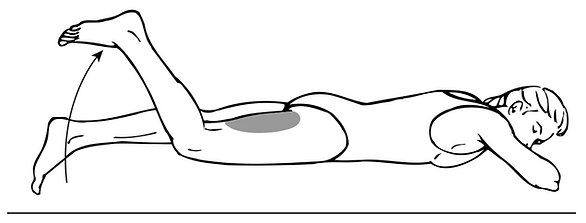
STRENGTH • Hamstring, Curls
-
Lie or your stomach with your legs out straight.
-
Bend knee to 90 degrees. Hold this position for _____ seconds.
-
Slowly lower your leg back to the starting position.
-
Repeat exercise times, times per day.
Additional Weights: OK TO USE DO NOT USE!!!
If okay’d by your physician, physical therapist, or athletic trainer, a pound weight may be placed around your ankle for additional weight.

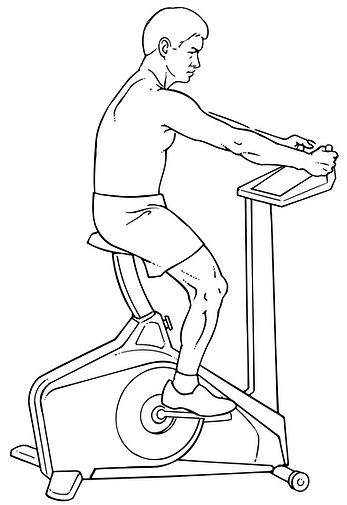
View as PDF
STRENGTH • Quadriceps, Short Arcs
-
Lie flat or sit with your leg straight.
-
Place a inch roll under your knee, allowing it to bend.
-
Tighten the muscle in the front of your knee as much as you can, and lift your heel off the floor.
-
Hold this position for seconds.
-
Repeat exercise times, times per day.
Additional Weights: OK TO USE. DO NOT USE!!!
If okay’d by your physician, physical therapist, or athletic trainer, a pound weight may be placed around your ankle for additional weight.